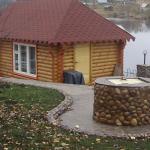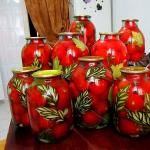Peculiarities of Estonian cuisine. Estonia: traditional cuisine
The main feature of Estonian cuisine is the simplicity and naturalness of dishes. When you come to this country, you can’t expect a sophisticated meal, but rather a homely atmosphere. Estonia is famous for its meat and fish dishes, as well as a variety of baked goods and vegetable dishes.
Culinary traditions of Estonia
Estonians do not use a large amount of additives in the form of seasonings and spices; ordinary salt, caraway seeds and marjoram are enough for them. It is very rare to find fried foods in the kitchen; all ingredients are mostly boiled. The most common food in Estonia is fish (usually herring), pork, a variety of vegetables and black bread.
As a rule, Estonian dishes are created from an unusual combination of products and have a special sour taste. It’s hard to imagine a native Estonian’s table without fermented milk products. Milk, curdled milk, yoghurts, cheeses are favorite delicacies in this country.
Basic typical dishes of Estonian cuisine
I would immediately like to mention Estonian soups. This is one of the delicious, satisfying and healthy national dishes. Many tourists are delighted with the original layout of the products. So, for example, in Estonia it is quite natural to find herring soup, sweet blueberry soup or beer soup, and ordinary soups with cereals, potatoes or peas are also served.

Can you imagine Estonia without fish? You should definitely try the smoked trout or grilled flounder. You will simply be delighted with the taste sensations you will experience!
Estonia is also rich in forest products. Many varieties of berries and mushrooms are grown here, so mushroom sauce, pickled saffron milk caps and mushroom salad are always present on the Estonian holiday table. Every housewife is sure to cook delicious jam from berries and fruits for the winter and make pickles from vegetables.
As for desserts, locals are very fond of cupcakes, pastries and sweets with unusual fillings. The pride of the country is Estonian chocolate with nuts. It is recognized as one of the most delicious in the world!
Several main national dishes of Estonia:
·Kartulipors – meat baked in mashed potatoes;
·Mulgipuder – pearl barley porridge with mashed potatoes;
·Mulgikapsas – a mix of barley stew, sauerkraut and pork;
·Vere pakeogid – pancakes with blood;
· Suitsukala - smoked trout;
· Dumplings based on barley flour;
· Tallinn sprats are a special sprat with spices, very popular among Estonians.

Favorite drinks of Estonians
Estonians love to treat themselves to various berry jelly, mead, birch and maple sap. Speaking of alcoholic beverages, we should highlight the national Estonian beer. By the way, it is also known outside the country. Each region of Estonia has its own beer recipe, with the most popular being Saku (light) and Saare (dark).
Local mulled wine “höegwein” is offered in almost every bar and cafe in Estonia. Trying it is a pleasure!
And two more famous Estonian liqueurs - Vana Tallinn “Old Tallinn” with a pleasant rum taste (it has been produced for more than fifty years) and Kannu Kukk, which very successfully combines a strong cumin taste and aroma!
5 best restaurants in Tallinn that you must visit
To experience the modern taste of Estonian cuisine, you need to go to the famous gastronomic establishments of Tallinn. We have selected some of the most popular and original vacation spots:
· Hell Hunt. Traditional food on Town Hall Square is simple but very tasty. Hell Hunt is located in the heart of the city. Almost every local resident will advise you to come to this establishment. The food here is tasty and inexpensive, however, there is one drawback - visiting Hell Hunt is not so easy; there are so many people who want to dine at this restaurant that you will have to book a table in advance, otherwise there may not be any free seats!
·Dunkri 5. Another establishment located near Town Hall Square. Excellent national Estonian cuisine is the highlight of this place! Very tasty beer is served here.
·Restaurant Ö. Get ready for an experimental and unconventional approach to local cuisine! This restaurant offers a wide range of dishes with unusual combinations.
·Restaurant "Vossa". The only restaurant in Estonia that has managed to gain worldwide popularity. It is one of the 50 best restaurants in the world and takes an honorable 15th place.

·Restaurant Ribe. The establishment is characterized primarily by the use of seasonal and fresh products! All dishes in the restaurant are prepared in accordance with European cuisine techniques and combine original flavor nuances. The restaurant has two halls, and in summer there is also an additional outdoor terrace.
For a country with a harsh northern climate, the cuisine is easy to prepare and satisfying.
Historical reference
Until the mid-twentieth century, Estonians did not really have a very varied diet, and bread was the king of any feast. Even the meaning of the word "bread" in Estonian "leib" has the general meaning of "food, edible". In addition, it was common to feast on salted herring, drink kvass and yogurt, and brew beer. A special dish from ancient times is kama.
Kama is still prepared today, already on an industrial scale - a ready-made mixture is produced for preparing kama. It contains a mixture of grains and legumes (oatmeal from peas, flour from rye grains, pre-roasted, crushed oats and barley). Similar to breakfast cereal, kama is poured with milk or consumed with curdled milk. Oatmeal jelly was also widespread, which was drunk with milk or butter.
The Estonians' lifestyle forced them to have breakfast and lunch in the field, so simple snacks were just a way to maintain energy and fill them up, but they usually sat down to eat a tasteful meal in the evening. Therefore, dinner was the most important meal of the day. As a rule, peasants ate bread with herring during the day and dined with bean soup. Porridges made from cereals and flour (for satiety) were also common in the diet.
In 1861, the abolition of serfdom led to a change in the nutritional situation, because now it became possible to prepare hot food for lunch. From now on, lunch became the traditional main meal of the day.
Estonians considered sausages to be a festive dish. By filling them with cereal, we came up with a method for preparing blood sausage.
Jellied meat was traditionally prepared for weddings, at family celebrations; barley porridge or pancakes were a ritual attribute dedicated to newborn family members.
Since potatoes appeared in the fields, they have replaced many cereals on tables. Potatoes were called second bread.

The twentieth century was an impetus in the industrial sense, economics, development, recipes brought from other regions began to form the main diet of Estonians and, although they were borrowed from the Germans, Russians, Scandinavians and Poles, the recipes took root in everyday life. Salads, pates and canning have enriched the Estonian cuisine.
Estonian cuisine today
Estonian cuisine is practical and nothing fancy was used for its dishes, only what the land and everyday life provided was revered and used. It is worth paying tribute: the dairy products on the Estonian table are of the highest quality, and today they are actively exported to other European countries.
Lean meat products, bacon, fish dishes, vegetables (cabbage, rutabaga), legumes and potatoes form the Estonian diet quite regularly, but what is especially noteworthy is the combination of unimaginable components (for example, potatoes in confectionery, milk with peas and fish in one dish) is amazing.
Estonians have a unique cooking technology. They have long preferred boiled food, and fried dishes came to them from neighboring countries, from which they borrowed recipes for cooking. But instead of traditional frying in oil, Estonians tend to replace the cooking technology by frying meat, vegetables, mushrooms in milk with sour cream or using milk and flour. There is no hard crust, and the dish does not have the smell of butter.

Boiled dishes have cooking features that are very interesting and unusual. Products are boiled in water, milk, kvass, a mixture of milk and sour cream, and an egg-milk mixture.
Due to the boiling temperature, the originality of taste and variety of Estonian dishes is achieved. Estonians do not like spices and herbs. They are rarely used on the table. Often dishes are not seasoned with anything at all, but for example, fresh dill is served with herring, blood milk is flavored with marjoram, cottage cheese with cumin, meat soups with parsley and celery.
Cold dishes are a very common trend, like among all Balts. It includes sepik - black or gray bread, salted, pickled fish, herring with sour cream and boiled potatoes, smoked herring, kama, boiled ham, bacon, rye-potato roll or potato salad, butter, hard-boiled eggs, milk, yogurt. Speaking of Estonian jellied meat, it is prepared from only one type of meat, the heads and tails of a cow or pig. The knuckle and legs are not used, but the tongue is included.

As for hot dishes in Estonian cuisine, there is a wide variety of milk-based soups (milk-cereal, milk-dough, milk-vegetable, milk-fish, milk-mushroom, milk-egg, milk-beer soups). A separate branch in the preparation of milk-based soups also contains dairy products in the recipe. Non-dairy soups are meat and vegetable recipes using potatoes, cabbage and beans. For satiety and taste, pieces of smoked lard and offal for fat are added to soups; a special aroma is obtained from the inclusion of smoked lamb, ham, corned beef or smoked bacon in the soup.
Of course, like in any northern country, the culinary scene in Estonia is rich in fish dishes. Common types of fish, such as flounder, fish, eel, pike, ruffe, vendace, are involved in the preparation of fish and milk soups, with the addition of cabbage. Second fish courses even include small fish and herring in casseroles. Sometimes they are enriched with dill and lard.
A wide variety of methods of preparing fish (hot smoking, drying, drying, salting) distinguishes Estonian cuisine. By the way, dried and dried fish are also used for soups.

Among the meat products Estonians venerate are lean pork, veal, lamb, and smoked corned lamb. Poultry and beef are not very popular; goose or game are even less common.
Among cooking technologies, slow boiling meat gives a very special taste to meat. It is prepared in large quantities in a thick-walled cast-iron bowl with a small amount of water. In the oven or on coals, “oven meat” gains full flavor and pure meat aroma (this is where the lack of spices pays off!). It is served cold, with boiled potatoes or other vegetables, sometimes they are combined into a separate dish with milk gravy.
Vegetables are a popular food among Estonians, especially if the recipe contains butter, sour cream, milk, cream, and sometimes lard is added. Desserts are also based on curd products, cream and jelly; thickets made from rhubarb, apples, lingonberries, and cranberries are very tasty and healthy.
Here are some recipes for classic Estonian cuisine.
Estonian milk and cereal soup
- barley 3/4 cup,
- potatoes 4-5 pcs.,
- milk 1.5 l,
- oil 1 tbsp. spoon.
After boiling the cereal until half cooked, add the potatoes and cook until tender, then pour in the milk, boil, add salt and butter.
Milk-vegetable soup with rutabaga
- milk 2 l,
- buckwheat or pearl barley 0.5 cups,
- swede,
- potatoes 5 pcs.,
- butter 2 tbsp. spoons,
- dill 2 teaspoons,
- cumin 0.5 tsp.
After boiling the cereal until half cooked, add chopped rutabaga, salt, after 10 minutes add potatoes, cumin and cook until tender, then pour in milk, boil, season with oil, sprinkle with fresh chopped dill.

Potato pigs
- lean pork 0.5 kg,
- mashed potatoes 1-1.5 kg,
- 2 eggs,
- sour cream 1 glass,
- milk 3/4 cup,
- rye or wheat flour and semolina 2-3 tbsp. spoons,
- butter 1 tbsp. spoon.
Cut the pork into slices 1 cm thick, fry in a frying pan, place inside mashed potatoes and roll into a bun, coat it with beaten egg, roll in flour or semolina, bake in the oven, and then pour sour cream on it when serving.
Herring in sour cream
- herring 2-3 pcs. light salting,
- onion 1-2 pcs.,
- dill 0.5 cups,
- sour cream 1 glass,
- milk 1 glass.
After cleaning the herring, divide the fillet into two halves, soak in milk (10-12 hours), then cut into pieces 1-1.5 cm wide and place in one layer on a dish. Place onion sliced into thin rings on top, pour in thick sour cream and sprinkle with finely chopped fresh dill. Boiled potatoes are suitable as a side dish.

Fish casserole in dough
- rye flour 0.5 kg,
- water 1 glass,
- yeast 30 g,
- cumin 2 tsp.
- fish fillet 0.5 kg and smoked lard 100 g
- Baltic herring (fillet) 0.5 kg fillet and salted lard 100 g
Knead the dough, let it rise, roll out 1 cm thick. Place the filling in several layers, pinch, giving the loaf an oval shape, coat the surface with cold milk. Bake at a temperature of 150-160 degrees Celsius in the oven (it must be preheated well) for 45 minutes - 1 hour.
Tip: river fish meat makes a good and tasty combination with smoked lard.
Rutaberry porridge
- rutabaga 2 pcs.,
- onion 1-2 pcs.,
- milk 1.5 cups,
- flour 1 tbsp. spoon,
- oil 1 tbsp. spoon.
Boil rutabaga in water, make a puree from it, add onion fried in oil, add salt, add milk and heat for 5-7 minutes, stirring.

Milk-vegetable mixture
- potatoes 1 kg,
- carrots 4,
- rutabaga 1,
- milk 2 l,
- flour 2 tsp,
- butter 1 tbsp. l.
Coarsely chop all the vegetables into cubes and simmer in a frying pan until almost ready, so that the water has almost evaporated. After diluting the flour in milk, pour this mixture over the vegetables, boil for 5-10 minutes, add salt and stir with butter.
Estonian cuisine is famous for its simplicity and naturalness. Historically, Estonians prepared their main dishes from pork or fish, cabbage, peas and dairy products; practically no spices were used.
Estonian cuisine does not differ in great variety and sophistication, which is due to the limited range of products historically available to residents of Estonia. Estonian cuisine is based on a variety of soups and porridges made from pork and fish (herring) with the addition of barley and pearl barley and vegetables (cabbage, peas, and later potatoes).
A typical breakfast consisted of porridge (barley, barley or oatmeal), sometimes milk, honey or jam were added to the porridge, and more often pork cracklings and butter were added. Each meal was accompanied by rye bread; salted herring was also a frequent guest on the table. For lunch and dinner, cabbage, pea or bean soup was prepared in pork broth.
The festive table was decorated with blood sausage with the addition of cereals, jellied meat and pancakes made from barley flour. The obligatory dishes on the table were dishes made from milk - cottage cheese, cheese and butter. With the advent of potatoes, the list of Estonian dishes has expanded significantly.
Modern national cuisine of Estonia
 The modern national cuisine of Estonia is diverse, many dishes are borrowed from other national cuisines - German (sausages), Hungarian (goulash) and Polish (bigos). Estonians still serve:
The modern national cuisine of Estonia is diverse, many dishes are borrowed from other national cuisines - German (sausages), Hungarian (goulash) and Polish (bigos). Estonians still serve:
- Aspic.
- Blood sausage.
- Roast pork and sauerkraut.
For Maslenitsa, Estonians fry pancakes from different types of flour (wheat, buckwheat, oatmeal) with a variety of fillings (lingonberries, caviar, fish, caviar, cottage cheese). Estonian cuisine has expanded with desserts and salads, for example, scones with whipped cream and potato salad are extremely popular.
Various pickles are widespread in Estonian cuisine:
- Pickled tomatoes and pumpkin.
- Salted cucumbers.
- Lecho and tomato paste.
Typical products for Estonian cuisine are milk, cheese, butter and cottage cheese. Recently, yogurt has been added to this list. Dairy products are consumed by Estonians in large quantities.
What to try in Estonia
 Most of the dishes worth trying in Estonia contain pork. The first place deservedly goes to the stew of pork, pearl barley and sauerkraut (mulgikapsas) - a fatty, very filling dish that must be eaten with rye bread. The next dish could be pork baked in mashed potatoes (kartulipors) - in many restaurants it is served in portions in the form of small pigs. For fish lovers, Estonian cuisine offers tender smoked trout (suitsukala).
Most of the dishes worth trying in Estonia contain pork. The first place deservedly goes to the stew of pork, pearl barley and sauerkraut (mulgikapsas) - a fatty, very filling dish that must be eaten with rye bread. The next dish could be pork baked in mashed potatoes (kartulipors) - in many restaurants it is served in portions in the form of small pigs. For fish lovers, Estonian cuisine offers tender smoked trout (suitsukala).
A popular dish among tourists is kama - a mixture of boiled cereals with jam, honey and milk. An excellent dessert would be a bun with marzipan or a marzipan figurine, which can be bought in shops in the center of Tallinn.
Before a gastronomic tour to Estonia, you must take care of obtaining a visa in advance. Read how to do it yourself.
National Estonian desserts and drinks
There are two main desserts in Estonia – onion jam and pepper cookies (piparkook).
Jam was traditionally made from onions with the addition of honey, but now honey is replaced with sugar. Pepper cookies are prepared with the addition of black pepper, cinnamon and ginger, and covered with glaze patterns. These cookies are still popular among Estonians at Christmas.
 National drinks include red beer and oatmeal jelly. Red beer is served in almost all traditional Estonian taverns, and the red color is achieved by adding berries. Oatmeal jelly is traditionally prepared from oats by long boiling. Added to oatmeal jelly:
National drinks include red beer and oatmeal jelly. Red beer is served in almost all traditional Estonian taverns, and the red color is achieved by adding berries. Oatmeal jelly is traditionally prepared from oats by long boiling. Added to oatmeal jelly:
- Berries.
- Milk.
Where to try
Tallinn is famous for its restaurants serving national cuisine. Among the large selection, we can highlight the most interesting and popular ones.
Restaurant MEKK
Restaurant MEKK offers traditional Estonian dishes in an original presentation. In accordance with the history of the country, the menu depends on the time of year - summer and autumn provide a variety of vegetables and fruits, autumn - berries and pickles, winter - meat and preserves.
The menu includes specialties - pork in lingonberry sauce, cake with sea buckthorn and cheese. Home-baked bread and only natural dairy products give the restaurant the status of a cozy and almost homely place.
Address: Suur-Karja 17/19, 10140 Tallinn.
Peppersack Restaurant
 Peppersack Restaurant provides the opportunity to try classic Estonian cuisine at its best:
Peppersack Restaurant provides the opportunity to try classic Estonian cuisine at its best:
- Pork stewed with sauerkraut.
- Kamu (a mixture of cereals with jam or milk).
- Blood sausage.
- Potato salad.
Dishes are prepared from natural Estonian products without special spices - only salt and herbs are added to the dishes. The deliberately simple interior allows you to focus entirely on the food.
Address: Viru 2 / Vana turg 6, Tallinn.
Restaurant Olematu Rüütel
The Olematu Rüütel restaurant is designed in a medieval style. In the restaurant's basement, game meat is roasted over an open fire. The menu delights with romantic names, for example, “Mistress Margaretha’s Weakness,” which hides chicken fillet with cheese, fruit salad and rice. The combination of products in restaurant dishes is unexpected and unusual.
The restaurant also serves traditional dishes - salted herring, pumpkin cream soup and ice cream.
Address: Kiriku Poik 4a, Tallinn.
Cafe Maiasmokk
 Cafe Maiasmokk is the oldest not only in Tallinn, but throughout Estonia. The cafe offers a wide selection of desserts and sweets:
Cafe Maiasmokk is the oldest not only in Tallinn, but throughout Estonia. The cafe offers a wide selection of desserts and sweets:
- Tender buns with cream.
- Handmade sweets made from natural chocolate.
- A variety of pies and pastries.
- Desserts with marzipan.
In the cafe you can also visit the marzipan room, where the whole history of marzipan is shown. The cafe has preserved its historical interior.
Address: Pikk tänav 16, Kesklinna linnaosa, Tallinn.
National Estonian cuisine may not be distinguished by its sophistication and variety of products, but everyone will find a dish to their liking.
Natural products and familiar cooking methods make Estonian cuisine attractive to Russian tourists.
A small country, its cuisine has a lot to offer. Traditional Estonian dishes are mainly based on meat (pork), potatoes, rye bread and tasty fish.
This was also influenced by nearby regions such as Scandinavia and Russia. Many dishes in Estonia are quite incredible and only adventurers dare to try them. Here is my list of the most interesting dishes that it offers:
Marinated eel
This dish is served cold. It sounds simple, but it is a favorite dish of Estonians. Be careful when you eat because there may be bones that you should eat.
There may also be more fishy flavor than you expect. Give it a try if you're adventurous - you'll love it!
Suite

Suite is one of Estonia's most popular dishes, but most foreigners are too afraid to try it. This is a meat jelly made from boiled pig bones. Sometimes the head and hooves are also boiled along with the bones.
It is usually prepared in large pots so that people can then put it in a jar and take it home. The smell may make you cringe, but just step out of your comfort zone and do it the way the Estonians do it.
Blood sausage

The British call this dish “black pudding” because it is very dark in color. This dish, also known as blood sausage, is a type of sausage that is prepared stuffed with blood and the blood is allowed to cool during the cooking process.
Usually eaten in winter; is a traditional Christmas dish. Typically eaten with cranberry jam and sometimes with butter and sour cream. Sounds awful? Just try it and find out!
Mulgicapsad

This is a dish of pork and stewed cabbage, served with boiled potatoes. It's quite a filling dish and you'll be full faster than you'd expect. Apparently, this is a healthy dish, because it is usually eaten when it is cold outside, because it is a kind of thick soup.
You don’t need to “pull yourself together” to try this dish, so perhaps this is a good start to get acquainted with Estonian dishes.
I hope you can find a dish that you enjoy... Of course, there are foreign dishes to try, but I want you to know about the local quirky dishes too. Enjoy!
If you liked the page

Traveling through an unfamiliar country is impossible without getting to know the local cuisine. In Estonia, cooking traditions have been significantly influenced by German, Danish, Swedish and Russian culture. Despite the fact that Estonian cuisine is not very well known in the world, it deserves attention - local food is distinguished by its original taste and a wide variety of snacks.
Historically, the main meal for the vast majority of the country's inhabitants occurred in the second half of the day. In the evening, the whole family gathered at the table: soup, a meat or fish dish, and drinks (milk, kvass, jelly) were served for dinner.
The specific features of Estonian cuisine finally took shape by the middle of the 19th century: it is based on simple preparations, hearty dishes of meat, fish, beans, cereals and potatoes. National Estonian cuisine is characterized by the use of a small amount of seasonings - due to the territorial and climatic conditions in Estonia, and also because for a long time they were very expensive. Today, the main spices in Estonian dishes are marjoram, cumin, pepper and salt, ginger, cinnamon and cardamom.
It is also worth noting the widespread use of milk and fermented milk products in cooking - they are included in sauces, hot dishes, soups and desserts.





When you arrive in Tallinn or any other city in the country, you should definitely go to several local restaurants to try Estonian national dishes. A kind of “calling card” of local cuisine is a variety of recipes that include pork, potatoes, cabbage and sauces based on milk and curdled milk.
To get the most complete picture of the traditions of Estonian cuisine, you should try the following dishes:
- Mulgikapsad - stewed pork, served with boiled potatoes and sauerkraut. This recipe, with slight differences, is also found in other Baltic countries and Scandinavia.
- Sult (sült) - traditional jellied meat. For a long time it was exclusively a “wedding” dish, but now it is served in many restaurants.
- “Tallinn sprats” in a spicy marinade - they are considered one of the main “edible symbols” of Tallinn, along with marzipan and hot wine with spices.
- A variety of potato and pea soups - they are usually prepared with the addition of smoked meat, which gives the dish a unique flavor.
- Hearty salads made from meat, potatoes and other vegetables. Sour cream and sauces based on it are usually used as a dressing for them.
In addition to the solid “lunch” food, you should definitely try other dishes of Estonian cuisine: cold appetizers based on cheeses or fish, dessert soups (berry, bread and honey), marzipan, pastries. While walking around Tallinn, especially in autumn and winter, street stalls with hot snacks will be a great way to warm up. They usually sell traditional Estonian dishes, the recipes of which have been adapted so that they can be prepared quickly: rye “envelopes” stuffed with fish or meat with herbs, blood sausage, hot pies “pirukad”.





You can’t ignore the variety of Estonian desserts. There are a great variety of them, and it is simply impossible to try everything in one trip, but many delicacies can be taken with you as souvenirs.
The most “important” delicacy in Estonia is marzipan. According to legend, it was invented in Tallinn: a mixture of nuts and sugar was first prepared in a pharmacy on Town Hall Square, and the city residents liked it so much that it quickly became part of the everyday and holiday menu. Now, by the way, there is a small Marzipan Museum in the pharmacy premises, where everyone will be told about the origins and recipes of this traditional Estonian dish. Marzipan candies are made with a variety of additives and decorated with nuts, candied berries, icing and chocolate.
An unusual and delicious rhubarb pie is also very popular in Estonia - you can order it in almost any cafe. Also among the national desserts are jelly (served with cold milk or cream), a variety of pastries (including Christmas spiced “piparkook” cookies), and berry soups.





Unlike national dishes, Estonian drinks are better known to the average resident of Russia. Perhaps the most famous liqueur is “Vana Tallin” (Old Tallinn), which is made from rum. Oddly enough, this drink is relatively young - its composition was invented in 1962. Today, several varieties of liqueur are produced, including blackcurrant and cream, which have a lower strength.
Various drinks based on milk and yogurt, compotes, kvass and beer are still popular among Estonians themselves. In Tallinn, for example, there are several private breweries at restaurants where you can try unusual types of foamy drink. Beer connoisseurs can try beer with juniper, honey or fruit. It is worth noting that Estonian beer is generally weak and is perfect for cooling off in the summer heat.
In winter, especially during the Christmas holidays, the local version of mulled wine - höegwein, which is warmed red wine with spices, becomes extremely popular.









